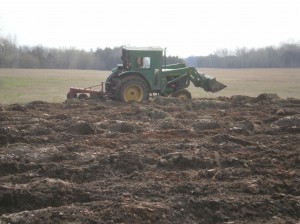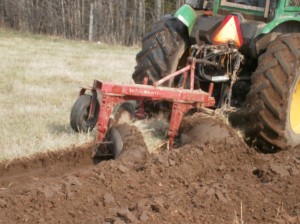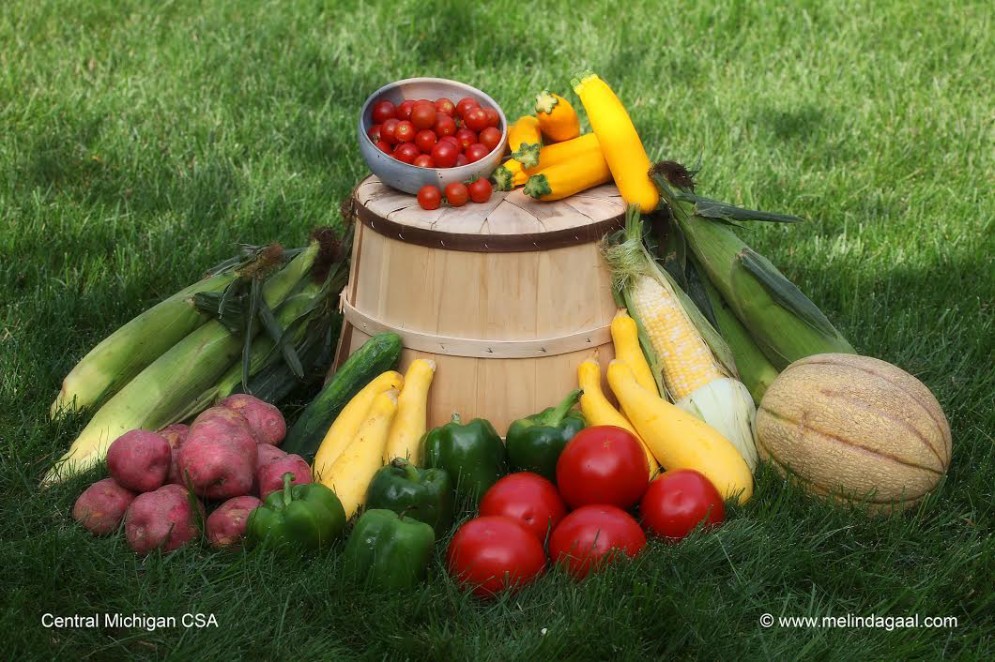Last week we finished up working both our ground we grew in last year and the additional ground for the Central Michigan CSA members this year. I wrote an article when we were doing the plowing and thought I do the same about the second step for us, discing. Our CSA or Farm Co-Op is located in Mid Michigan and we serve the surrounding area if your interested in learning more about the CSA program or want to become a memeber, fill out the CSA Newletter form on the side of this web page.
We only plow new ground or ground we planted a cover crop on the previous fall, but we choose to disc everything both new and last years planting areas whether we had a cover crop or not. Plowing runs deaper, up to 10″ or so, and discing works with the overturned topsoil that the Plow leaves behing.
Why Do We Disc?
We disc because it’s a productive way to loosen the soil after a wet spring and frozen winter. It allows air into the soil which is critical for plants to do well. Plants need oxygen AND they need it at their ROOTS. Discing also cuts up any larger pieces of sod in newly plowed ground and (hopefully) kills the grasses and weeds that then become organic matter to feed this year’s vegetable crop. Another thing the disc helps accomplish is a level planting area.
What’s Next?
We plant on raised beds and use mulch and drip lines to irrigate. This avoid the actuall plants from being wet and reduces disease, blights and bugs without using insecticides. It also complete reduces weeds growing within a foot or so on either side of the plant. We don’t spray for weeds either. The raised beds require a “raised bed machine” to install them at the scale we grow on so we have to take one more step and run a 5′ rototiller over the ground just before we make the beds. That’s the next step before we plant which we are starting Thursday outside. We already have some stuff started in the High Tunnel, but Thursday will be the first trasplants to actually go out side. The ten day forcast looks good and May is just around the corner.
If you are growing your own vegetable garden I recommend waiting until Memorial Day weekend to plant. If you plant earlier like we do, then be prepared to cover your plants. We expect to have at least 6 or so nights where frost will be a factor and we prepare for that. On a small garden scale you can use a milk jug with the bottom cut out to cover your plant. Make sure to take the CAP of the jug. We use what is called frost cloth or low tunnels which consist of metal hoops about every 6′ or so that supports a light plastic film to provide protection from frost and additional warmth on cooler days.
Hey There!..We Have a Great Facebook Page! Go and LIKE it Now...Interested in The CSA? Go Here--> CSA Farm Thanks for visiting!

Plowing Turns Over The Earth
The plants are started and the seeds are waiting for the 2012 growing season and thanks to the Caribbean like weather we’ve been having here in Central Michigan we’ve got the plowing done, and in March no less! We needed to work up more ground for the 2012 CSA program and I also worked up a good piece of ground in the Back Field for some winter squash, pumpkins, and watermelon. I decided to put them in their own area as the climb and crawl like crazy and are a later crop as well. This also allows me to use the front field to better stage the vegetable plantings so we have a longer harvest season on each variety. The early round will be transplanted into the field soon along with another planting that goes into high tunnels.
Why Do We Plow?
Plowing is a natural farming method that reduces weeds and improves soil for growing since we don’t spray weed killers, we need to plow instead. Sometimes we plant cover crops like rye or winter wheat and plow it down in the spring or fall then plant. The cover crop gives the new years plants organic matter that turns into nitrogen and helps the plants to grow and make good size. Cover crops can also be disc-ed rather than plowed and another benefit they provide is keeping weeds from growing. You don’t have to plow every year but we grow most of our produce in the front field that has been pasture for years, so when we expand the growing area we need to turn that pasture under and prep it for planting. Did you know that the plow is one of the hardest pieces of farm equipment to pull?
Prepping Ground to Grow Good Vegetables
Plowing is just the first step, once that is done we hook on to the disc is which is a simple machine with a bunch of saucer looking cutting discs. The disc cuts up the plowed ground and lays the field down in the process. Notice in the picture above how bumpy the ground is, that’s what it looks like when it’s plowed. We go over the field several times with the disc cutting the chunks of overturned sod into smaller pieces and cutting up root systems from the grass. Meanwhile the overturned earth will start decomposing creating vital nutrients for the plants that will soon be growing there.
The next step is dragging the field which further levels the area and removes clumps of sod and leaves the field somewhat ready to plant. In fact if you were going to plant a traditional agricultural crop it would be ready for the planter at this point. We plant a large variety of vegetables and because we us a raised bed system and raised bed machine we need to do one more thing and that is to rototill. Rototilling the ground before we run the raised bed machine just fluffs the ground and breaks up any remaining clumps. The clumps can cause the mulch to tear and interfere with our irrigating drip lines. The raised bed machine actually makes the raised beds, installs the mulch and installs the low pressure drip lines all at once. Once the beds are in and the drip lines hooked up we are ready to plant.
So, it was 80 degrees the other day and it was March 18th, pretty cool right? Yep, I’m not complaining either. Since the Opening Day of the Market and the start of our Central Mi CSA program both are affected by the weather I thought I’d share what this could mean for the 2012 produce season. Of course I don’t have a crystal ball and who knows what April will bring, but I’m guessing rain and slightly above normal temps with at least 2 cold dips. These 70 and 80 degree days do affect Michigan produce especially the perennial types like asparagus, strawberries, blueberries, and most fruit trees too. The obvious concern is an early budding and growth spurt among fruit trees then a frost during blossom, that makes for a poor crop and high prices, things we don’t like. I talked with a friend the other day who grows several acres of asparagus and he thinks he’ll have asparagus by Mid to late April if the weather between now and then looks average. These warm days really cause the ground to warm and the plants to start their growing season. Cool weather can slow it but as long as it’s in the 50’s and 60’s plants will still grow. Some years they don’t start until early May just to give you an idea, strawberries are already growing in the fields.
Weather and The Central Mi CSA
So what am I doing and how is the weather going to affect the CSA? Well, I’m planning on asparagus and strawberries, which are the first fruit and vegetable we usually have, being early by about 2-3 weeks and I’m working on having a variety of other crops ready too. We’ve got tomatoes, peppers, cucumbers, lettuce, green beans, and some squash started already. We usually wait about two more weeks on the cucumbers and squash, because the start so quick and they have a short maturity date. I’ve been looking for more 45-60 day stuff to start too that will compliment the fresh Michigan asparagus and strawberries in May. Just to be safe we will also be planting in the High Tunnel so if we get damage from the cool dips that will surely come we’ll still have lots of good food.
CSA Shares
We still have around 20 CSA shares left for the 2012 season, you can purchase a 1/2 share or a full share and we are also offering a “Market Share” that lets you save around 15% to 20% at the market this summer. You can learn more about our Mid Michigan CSA Farm by visiting the “Join the CSA” page.



